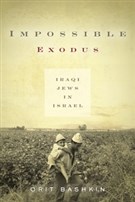During the past week Americans, Europeans, and Middle Easterners were reminded of Iraq. A stream of photos, articles, essays, and analyses has tried to make sense of the situation in Iraq during the last decade. One group, however, does not need to be reminded of the gravity of the situation—the many Iraqis, men and women alike, whose lives have been irreversibly changed during the last decades.
In this piece, I want to reflect on the kinds of themes historians have been writing about in the present, and those we ought to write about in the future. In the last ten years, we seemed to have learned much more about Iraqi history; probably more than any of us has ever imagined upon entering graduate school, as our field witnessed the publication of dozens of academic books, articles (including ones published in The International Journal of Contemporary Iraqi Studies), and dissertations. Thus, we now seem to better understand gender relations in Iraq as well as the country’s Diasporas and trans-regional and social networks. We are more knowledgeable about Iraqi patriotism and Arab-Iraqi nationalism. We have learned to appreciate Iraq’s culture, namely its astonishing literary production, the ways in which Iraqi poets revolutionized the field of modern Arabic poetics, and the writings of Iraq’s gifted novelists, whose works have appeared in translation in the last decade. We comprehend better various mechanisms related to the state: the development of its health system, the production of its social memory, its disciplinary institutions—especially its education system—and, significantly, its production of sectarian policies. Historians have likewise attempted to analyze Iraq’s relations with the British Empire, and the modes of resistance to empire, especially the 1920 Revolt. The controversial move that brought the Baath Party archives to the United States in 2008 will enable those who work in these archives, as well as their readers, to know much more about the Baath regime and the ways in which it functioned, possibly more than any other Middle Eastern regime.
Two points, however, should be made in connection to this historiographical shift. The first is that while we presently know more about Iraqi history, we will probably know much less about certain aspects of Iraqi history in the future. With the destruction of many of Iraq’s Ottoman records, public libraries, and state archives, and with the looting of many of its museums and archeological sites, our access to Iraq’s past would rely on non-Iraqi voices. Reconstructing local Iraqi voices, without newspapers, cultural magazines, court records, manuscripts of legal, poetic, and theological works, and many other texts, will become increasingly difficult. A second, related point has to do with the fact that the scholarship we have produced has not reached the broader public. While the new scholarship on Iraqi history underscored the constructed nature of Iraqi sectarianism, and the involvement of the state and the colonial powers in producing sectarian identities, the public received a notion of an Iraqi society divided by a sectarian logic dating back to the seventh century. Whereas numerous scholars, as well as Iraqi intellectuals, writers, and poets, underlined the commitment of many Iraqis to a democratic project, the depiction of Iraq in the media was that of an undemocratic monolith dating back to antiquity. In the academic universe, historians and social scientists have championed the efforts of Iraqi women to achieve and defend their rights, in the past and in the present. And yet, the very same women were often represented in the media as ones in need of rescuing by others. True, there were many important and serious accounts in the press and in cyberspace, but the old, familiar concoction of Orientalism and tribalism, peppered with a few new binaries regarding the unbridgeable gaps between Iraqi Arabs and Kurds, and Iraqi Shi‘is and Sunnis, soon took root.
This interest in the past, in light of the present, brought to the surface waves of nostalgia to a variety of pasts: to Ottoman multiculturalism; to the openness typifying the days of monarchy; to the anti-sectarianism of ‘Abd al-Karim Qasim’s era; to the oil boom and the economic prosperity of the 1970s, and even, by some, given the harsh realities of the last decade, to Saddam Hussein’s regime, when, as the argument went, at least there was some sense of law and order in Iraq. These waves of nostalgia, the searches for a model past that was better than the present, were both positive and negative. On a positive note, they reminded us of various democratic, pluralistic, anti-colonial, and feminist moments in Iraqi history. These waves, however, have also allowed us to forget certain things: the institution of anti-Shi’a policies under the Ottomans, the collaboration between the monarchic elites and colonial powers, and the oppression of the Left under the monarchy, the communists in particular. They have also caused us to ignore the destruction of the Assyrian and the Jewish communities in these years, and the growing antidemocratic and authoritarian features of Iraq in its republican eras, especially under the Baath’s brutality.
It seems to me that as historians, social scientists and humanities professors, our role is to challenge these narratives and present a more complex version of Iraqi realities. If I had to single out one domain at which I think our efforts should be directed, I would suggest it is documenting, studying, and analyzing the quotidian, or, in other words, what it meant to be an Iraqi in the last three decades. Our attention should be directed at the children who struggled, and often succeeded, to get an education as the educational system around them collapsed; the men and women who had to search for medical treatment outside of Iraq; the ordinary citizens who lost any sense of personal security because of the recent civil war; those who lost their jobs due to the collapse of the Iraqi economy or because of the processes of de-Baathization that harmed many non-Baathists; the members of the religious communities who found themselves facing minoritization processes; the Iraqis living in the Diaspora who had to deal with the realities of their families at home; the injured, the bereaved, the refugees. These men and women, young and old, lived in the North, the center, and in the South, in cities and in villages, and they belonged to different religious and ethnic communities. Importantly, they include many activists, in both Iraq and the Diaspora, who had worked on behalf of their community, for such cases as gender equality, religious freedom, labor rights, as well as merely documenting the harm inflicted on Iraqis in modern times. Their histories do not start in 2003. To write their modern histories, in the insightful ways in which many of my friends and colleagues have done in the last decade, means understanding the lives of the forgotten protagonists of Iraqi history. Most crucially, it means avoiding, and overcoming, what Dina Rizk Khoury has recently identified as the “set of symbols and catch phrases—Saddam Hussain, the sanctions, WMD, Ba’th oppression, humanitarian crisis, and so on—that wiped out Iraqis as complex and active agents in the making of their own history.” If we do not engage in such projects, the Iraqi past might turn into the text depicted in Sinan Antoon’s masterful I’jam; an undecipherable riddle, whose true meanings are lost to violence, oppression, and death.
![[Iraqis waiting in line for food handouts in northwestern town of Biaj, 1 October 2009. Image from Fotopedia/DVIDSHUB.]](https://kms.jadaliyya.com/Images/357x383xo/OLDMAN.jpg)





